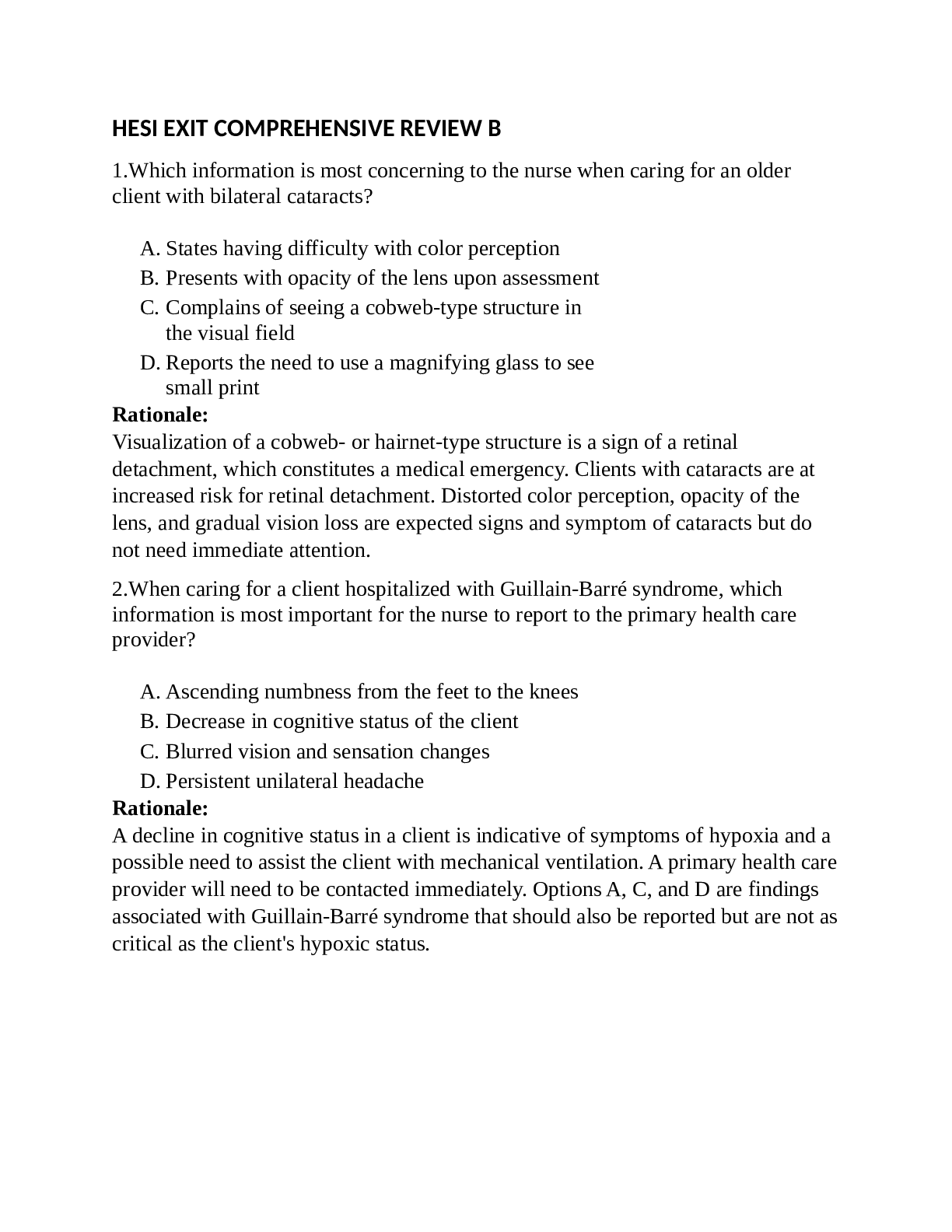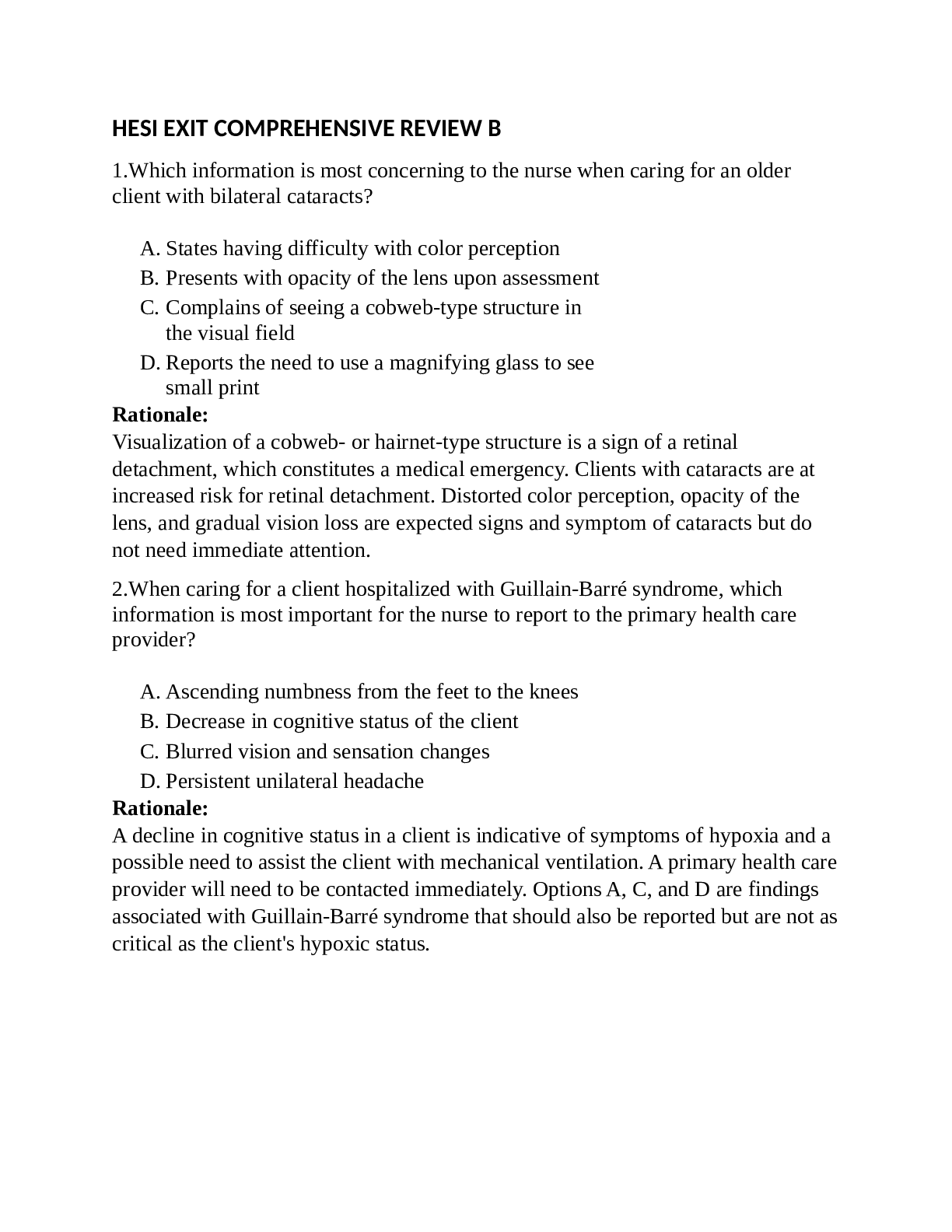HESI EXIT COMPREHENSIVE REVIEW B
1.Which information is most concerning to the nurse when caring for an older
client with bilateral cataracts?
A. States having difficulty with color perception
B. Presents with opacity of the lens upon assessment
C. Complains of seeing a cobweb-type structure in
the visual field
D. Reports the need to use a magnifying glass to see
small print
Rationale:
Visualization of a cobweb- or hairnet-type structure is a sign of a retinal
detachment, which constitutes a medical emergency. Clients with cataracts are at
increased risk for retinal detachment. Distorted color perception, opacity of the
lens, and gradual vision loss are expected signs and symptom of cataracts but do
not need immediate attention.
2.When caring for a client hospitalized with Guillain-Barré syndrome, which
information is most important for the nurse to report to the primary health care
provider?
A. Ascending numbness from the feet to the knees
B. Decrease in cognitive status of the client
C. Blurred vision and sensation changes
D. Persistent unilateral headache
Rationale:
A decline in cognitive status in a client is indicative of symptoms of hypoxia and a
possible need to assist the client with mechanical ventilation. A primary health care
provider will need to be contacted immediately. Options A, C, and D are findings
associated with Guillain-Barré syndrome that should also be reported but are not as
critical as the client's hypoxic status.3. A client is admitted with a diagnosis of leukemia. This condition is manifested
by which of the following?
A. Fever, elevated white blood count, elevated
platelets
B. Fatigue, weight loss and anorexia, elevated red
blood cells
C. Hyperplasia of the gums, elevated white blood
count, weakness
D. Hypocellular bone marrow aspirate, fever,
decreased hemoglobin level
Rationale:
Hyperplastic gums, weakness, and elevated white blood count are classic signs of
leukemia. Options A, B, and D state incorrect information for symptoms of
leukemia.
4. The nurse enters the examination room of a client who has been told by her
health care provider that she has advanced ovarian cancer. Which response by the
nurse is likely to be most supportive for the client?
A. "I know many women who have survived ovarian
cancer."
B. "Let's talk about the treatments of ovarian
cancer."
C. "In my opinion I would suggest getting a second
opinion."
D. "Tell me about what you are feeling right now."
Rationale:
The most therapeutic action for the nurse is to be an active listener and to
encourage the client to explore her feelings. Giving false reassurance or personal
suggestions are not therapeutic communication for the client.5. A nurse working in the emergency department admits a client with full-thickness
burns to 50% of the body. Assessment findings indicate high-pitched wheezing,
heart rate of 120 beats/min, and disorientation. Which action should the nurse take
first?
A. Insert a large-bore IV for fluid resuscitation.
B. Prepare to assist with maintaining the airway.
C. Cleanse the wounds using sterile technique.
D. Administer an analgesic for pain.
Rationale:
High-pitched wheezing indicates laryngeal stridor, a sign of laryngeal edema
associated with lung injury. Airway management is the first priority of care.
Options A, C, and D are all appropriate interventions in managing the client with a
burn but are not as critical as establishing an airway.
6. The nurse walks into the room and observes the client experiencing a tonic-
clonic seizure. Which intervention should the nurse implement first?
A. Restrain the client to protect from injury.
B. Flex the neck to ensure stabilization.
C. Use a tongue blade to open the airway.
D. Turn client on the side to aid ventilation.
Rationale:
Maintaining the airway during a seizure is the priority for safety. Options A, B, and
C are contraindicated during a seizure and may cause further injury to the client.
7. Which intervention should be included in the plan of care for a client admitted to
the hospital with ulcerative colitis?
A. Administer stool softeners.
B. Place the client on fluid restriction.
C. Provide a low-residue diet.
D. Add a milk product to each meal.
Rationale:
A low-residue diet will help decrease symptoms of diarrhea, which are clinical
manifestations of ulcerative colitis. Options A, B, and D are contraindicated and
could worsen the condition.8. A nurse implements an education program to red
Read More


